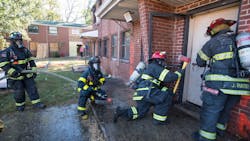Don't Miss Your Spot at Firehouse Expo's HOT Training
Several new programs have been added to Firehouse Expo’s hands-on training line up this year, along with the return of several intense live-fire training classes. Register soon to make sure you can reserve the classes you need at this year's conference, Oct. 8-12 in Nashville.
New this year is a unique program that offers students the chance to learn about lifting and stabilizing big rigs. Think cement truck, school bus or box truck with an occupied vehicle underneath. How will your crew be able to lift the commercial vehicle off the passenger vehicle, stabilize it and remove the patient?
Instructors from Spec Rescue International and Blue Collar Training Network will help rescuers develop an incident action plan, establish working relationships with tow operators, stabilize and prevent movement of the commercial vehicle in all directions, and utilize a 5-step process to separate the passenger vehicle from the commercial vehicle.
Thermal imaging guru Andy Starnes will lead “Tactical Thermal Imaging: Enhancing Fireground Performance” at the Nashville Fire Academy.
This will help enhance firefighter's decision-making skill sets by providing them with the skills to understand thermal data and how it impacts fireground operations. Under live fire conditions, students will work through a number of scenarios to better understand the use of the thermal imagers and apply these lessons on the next call they respond to.
Kevin Lewis returns to Firehouse Expo as the lead instructor for “Aggressive Fire Control, Flow Path, and VES Tactics.”
This class features a variety of scenarios in live fire conditions that provide students with the skills needed to control, isolate and understand live-fire behavior with specific focus on fire control, fire behavior and vent-enter-search operations. Lewis and his cadre – comprised of firefighters from Cobb County, GA, and Los Angeles County, CA, - take students through a series of stations to build their skill sets.
Dig deep into today’s truck company operations with “Modern Truck Company Operations,” led by Kevin Larkins.
Students will work through several skills stations focused on the primary functions of truck company, including forcible entry techniques, independent search, ladder placement and vertical ventilation.
Larkins and his group of instructors from some of the busiest fire departments on the East Coast will present a program that helps firefighters sharpen their skills, whether they are assigned to an under-staffed truck company or an engine or rescue company that conducts all fireground duties.
“RIT Under Fire” offers firefighters the change to sharpen their rapid intervention skills in a variety of scenarios, including a large-scale RIT deployment drill.
Gary Coney and his group of instructors from the Illinois Fire Service Institute cover firefighter drags, lifts and carries and heavy lifting with a variety of rescue tools.
Adding the element of live fire conditions, each student will be mentally and physically tested.
Getting water on the fire is the most important job at structural fires and Jonathan Hall’s hands-on class helps students understand basic and advanced hoseline skills.
“The Initial Engine Company Operations” helps students develop techniques, design attack packages, and implement tactics for engine companies. This session includes six work stations using 1 ¾” and 2 ½” hoselines in a variety of scenarios.
Often, fireground operations are slowed from the start by forcible entry scenarios that challenge firefighters.
In “Down and Dirty Forcible Entry,” Robert “RJ” James leads a group of veteran instructors who will walk students through street-smart forcible entry and then apply those skills using a number of props.
This class is designed for urban, suburban and rural firefighters to build their knowledge of locks and forcible entry challenges including heavy security at today’s structures.
The International Society of Fire Service Instructors will share the latest on basement fire operations in their “Understanding and Fighting Basement Fires” program that features live fire training following a classroom discussion.
Matt Hoppel will bring “science to the streets” using small-scale props and full-scale flow-path simulation stations to develop and enhance your knowledge of modern fire development and flow path. Students will learn about thermal imager usage and fire attack.
From the pages of Firehouse Magazine, Ron Moore offers eight hours of University of Extrication training.
Fire departments are being called to less crashes with entrapment than in years past, but Moore offers this program a refresher for veteran firefighters and a skill-building set up for younger firefighters.
Moore and his instructors will lead students through over 50 extrication assignments using a variety of tools and equipment based on NFPA 1006- and 1670- technician-level vehicle rescue skills.
Firehouse Expo features a unique one-day session that help firefighters prepare for responses to drug lab situations.
“What’s Really Cooking: A Firefighter’s Strategic Approach to Clandestine Labs” is divided into four groups that focus on a production lab and milling operation and covers the toxic effects of these labs on firefighters. The class includes detection equipment needed to safely mitigate clandestine labs.
Operations covered in this class include BHO extraction with butane, fentanyl responses and iodine-based labs. Mike Wilkerson, a veteran hazmat instructor and expert on clandestine lab operations, will lead this small class through eight hours of education.
Find all the details on Firehouse Expo's 2019 HOT classes here and click here to register before it is too late.
